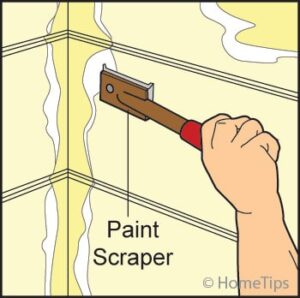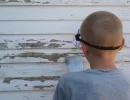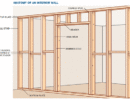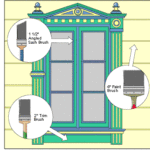How to fix typical problems that develop with exterior house paint, such as peeling, blistering, sagging, chalking, and alligatoring.
House paint offers a durable, protective coating that will protect house siding for many years when properly applied and maintained. But problems with paint do occur—either because of improper application or simple wear and tear. Here is a look at how to deal with typical house paint problems:
Fix Peeling Paint
Peeling paint usually indicates that the paint did not adhere to the surface to begin with. This happens when paint is applied to damp wood, loose or flaking paint, or to a dirty or greasy surface.
Peeling paint usually calls for repainting. To avoid peeling paint in the future, thoroughly wash the surface and be sure to completely scrape any loose paint from it. Sand and fill any nicks and gouges, prime before repainting, and paint only in dry weather.
Fix Blistering Paint
To repair a paint blister, first cut open the blister and break away the paint. If you discover bare wood underneath, you know the blister was caused by moisture in damp wood that was trapped behind the paint seal and fought to get out.
If the surface beneath the blister is painted, paint solvent was probably trapped under a surface layer that dried too quickly.
Blisters are often localized, so complete repainting may not be necessary. To avoid either of these problems in the future, scrape the blistered area, sand it smooth, make sure the surface is completely dry, and then prime and paint but not in direct sunlight.
How to Fix Chalking Paint
All siding paint produces a slight chalk-like substance—this is normal and allows a good rain to rinse dirt off the siding. Excessive chalking, on the other hand, dulls the paint’s color and sheen. Power washing the siding may solve the problem; if not, you’ll have to repaint.
Fix Wrinkling or Sagging Paint
Lumps, wrinkles, sagging, and similar imperfections in surface texture indicate that someone was in a hurry when they painted. These problems are usually caused by careless paintbrushing or rolling and by applying a too-heavy top coat. You will need to repaint, making sure to apply the paint according to the label directions.
Fix Alligatoring Paint
When a surface is cracked like alligator skin, it usually means one of three things: The paint is so old that it no longer has any resilience to changes in the weather, a newer top coat didn’t adhere properly because it was not compatible with the primer or bottom coat, or, the paint was applied before a previous coat was dry.
A badly cracked paint surface should be repainted, but before you do this you’ll need to remove the old paint. To avoid alligatoring in the future, make sure the paint you choose is compatible with the primer, and allow the bottom coat to dry completely before applying the next coat.
Remove Lead-Based Paint
Houses painted before 1978 may have paint that contains lead, which can be hazardous— especially to children—both through physical contact and breathing dust from sanding or scraping the surface.
If you suspect that your home may have lead-based paint, request information on how to properly remove it from your public health department or the Environmental Protection Agency at (800) 424-LEAD.t>








 Don Vandervort writes or edits every article at HomeTips. Don has:
Don Vandervort writes or edits every article at HomeTips. Don has:



